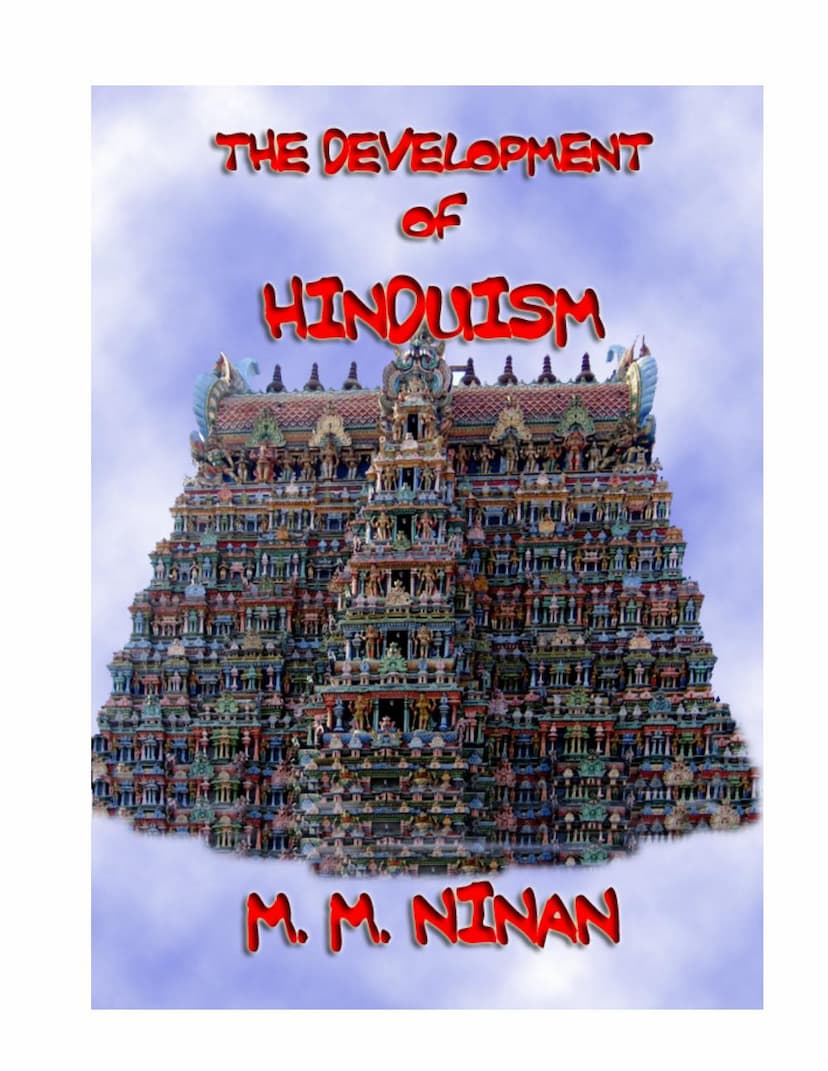Development Of Hinduism
Added to library: September 1, 2025

Summary
Based on the provided text, here's a comprehensive summary of "The Development of Hinduism" by M. M. Ninan, focusing on the initial chapters provided:
Overall Thesis: The book argues that Hinduism, as it exists today, is not a direct or unbroken continuation of the ancient Vedic religion. Instead, it posits that Hinduism underwent significant transformations and syncretism due to various external influences, most notably Christianity (specifically the ministry of St. Thomas), Gnosticism (particularly Manichaeanism), and potentially interactions with other cultures. The author contends that many core concepts of modern Hinduism, such as the Trimurti, monotheism, the doctrines of Karma and Reincarnation (in their later Hindu interpretations), Puranic deities, temple worship, and Sanskrit as a religious language, emerged or were significantly shaped after the Vedic period and, crucially, after the arrival of St. Thomas in India around 52 AD.
Key Arguments and Observations:
-
The Vedic Religion (Chapter 1):
- Vedic religion is presented as the earliest religious stratum in India, originating from Indo-European speaking peoples who entered India around 1500 BC.
- It was primarily a polytheistic system with a focus on nature worship, with Indra being a prominent deity.
- Rituals centered on animal sacrifice and the use of Soma.
- The Vedas themselves are a collection of hymns, with the Rig Veda being the oldest. The author emphasizes that Mandalas I and X of the Rig Veda are of later origin, possibly compiled well into the Christian Era.
- The language of the early Vedas, Vedic Sanskrit, is distinct from Classical Sanskrit, which the author claims came into existence only around the 2nd century AD.
- The author points out that the Vedic gods were largely connected to natural phenomena, a stark contrast to the personal, anthropomorphic deities of later Hinduism.
-
Dating of the Vedas (Chapter 2):
- The author strongly challenges the orthodox Hindu claim of the Vedas being eternal and divinely revealed (apaurusheya).
- He highlights the Anukramanis (indices) which attribute authorship of hymns to specific Rishis, thus proving them to be man-made works.
- Linguistic and textual analysis suggests that Vedic Sanskrit is related to Avestan, pointing to a Proto-Indo-Iranian origin around 2000 BC.
- Critically, the author states that the Rig Veda was not written down until the 2nd century BC, and other Vedic texts (Samhitas, Brahmanas, Upanishads) appeared even later, in the post-Christian period, written in Sanskrit.
- The author dismisses traditional Hindu dating of the Vedas to trillions of years ago as unscientific.
-
Timeline of Early Civilizations and Religions (Chapter 3):
- This chapter provides a broad comparative timeline, contrasting the development of writing systems and religious documentation in civilizations like Egypt, Sumeria, China, and the Indus Valley with the predominantly oral tradition of Vedism in India.
- It emphasizes that other major civilizations had established written scriptures and complex religious thought much earlier than India, where Vedism remained oral until the 2nd century BC.
- The author implies that this lack of early written documentation in India contributed to the ease with which later religious concepts could be introduced and integrated.
-
The Significance of Sanskrit (Chapter 4):
- The author argues that Sanskrit, as a fixed, codified language with strict grammatical rules (as defined by Panini around 400 BC), is a relatively recent development compared to Vedic Sanskrit.
- Archaeological and linguistic evidence suggests Sanskrit came into existence around the 2nd century AD.
- The author suggests that the renaming of Vedic language to "Chandasa" and then later to "Sanskrit" was a deliberate attempt to claim antiquity for Sanskrit-based scriptures.
- The earliest Sanskrit inscriptions are dated to 150 AD, while Prakrit was the dominant language in earlier inscriptions, including those of Ashoka (3rd century BC).
-
Post-Christian Hindu Gods (Chapter 5):
- A significant point is made that most of the deities prominent in modern Hinduism (Siva, Rama, Hanuman, Durga, Kali, Saraswati) are not found in the Rig Veda, except for a minor role for Vishnu.
- The author asserts that these new deities and their associated myths developed primarily in the Puranas, which are post-Christian texts (mostly dating from the 4th century AD onwards).
- He argues that the shift from nature worship in Vedism to the polytheistic and henotheistic worship of personal, anthropomorphic gods in later Hinduism indicates a fundamental change, possibly due to external influence rather than a natural evolution from Vedic roots.
-
Development of Monotheism, Karma, and Reincarnation (Chapter 6):
- Vedism is characterized as a nature-worshipping religion with no concept of a monotheistic Supreme God (Isvara, Bhagavan).
- The author claims that monotheistic concepts, as well as the doctrines of Karma and Reincarnation (as understood in later Hinduism), are not present in the Rig Veda.
- He argues that monotheism entered India through contact with Jewish religion during the Nebuchadnezzar period and more significantly through the ministry of St. Thomas in the 1st century AD.
- The author suggests that the monistic and henotheistic tendencies seen in later Hinduism (Saivism, Vaishnavism, and the Smarta tradition) are influenced by Christian and Islamic monotheism, and that figures like Shankara were exposed to these ideas in Kerala.
- The concept of Karma and Reincarnation is presented as having potential roots in Buddhism and Jainism, but its detailed elaboration in Hinduism is seen as a post-Christian development, possibly influenced by the need to explain suffering and the cycle of birth and death in a way that resonated with existing philosophical trends and later theological imports.
In essence, the book aims to deconstruct the traditional narrative of Hinduism's origins, arguing for a more historically and archaeologically grounded understanding that acknowledges significant external influences, particularly from early Christianity, in shaping the religion into its modern form. The author repeatedly contrasts the early Vedic period with the post-Christian era, highlighting the introduction of key concepts and deities that were absent in the earliest Vedic texts.